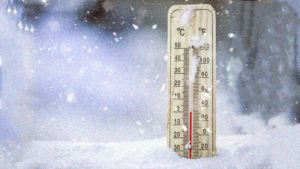Help your home stand up to winter – Winterizing your home

You can take steps to ensure your home is well prepared for winter weather – and that your family doesn’t get any colder than they want to be. Consider these suggestions for your comfort and safety.
INSPECT THE HEATING SYSTEM
Save time, money and frustration by avoiding the late night or weekend call to a heating contractor because your furnace isn’t working. Spending about $90-$110 for a scheduled service call when it is convenient for you may help avoid the high cost of repairs in an emergency or the risk of having to leave your home until those repairs can be completed. Performing routine maintenance every year – every other year at least – may help extend the life of your furnace and can promote your family’s comfort and safety.
PREVENT PIPE FREEZES
Exposed pipes in unheated areas can freeze and result in burst pipes that cause water damage. Use insulating pipe sleeves on the entire length of any exposed pipe, including bends and joints, then seal with duct tape. You could opt to let water drip from faucets, but this practice will increase your water usage costs and may not work effectively to prevent pipes from freezing in extremely cold temperatures. It is important to remove exterior hoses, shut off water leading to those exterior connections and open exterior faucets to allow any remaining water to drain from the line. Additionally, open kitchen and cabinet doors to allow warm indoor air to circulate around pipes along exterior walls.
If a pipe freezes, don’t attempt to thaw it using any type of exposed flame, such as a propane torch. Try a hairdryer, or call a reputable plumbing contractor for assistance.
SEAL AIR LEAKS
Check exterior window and door frames to ensure no gaps could allow outside air into your home. Any gaps greater than about 1/16 to 1/8 inch should be sealed with a silicone caulk, which is best for exterior use because it won’t shrink and can handle the elements. Don’t forget to inspect the window pane glazing and replace any areas that have deteriorated. You’ll also want to check your door seals and weather stripping. Can you see daylight from inside your home? If so, add new seals and weather stripping to further reduce air leaks.
CHECK THE ROOF
Inspect the roof system to make sure there aren’t any loose, damaged or missing shingles that can lead to water leaks. Not comfortable climbing the ladder? You can try using binoculars to get a closer look, but you can’t see the entire roof system. You may want to hire a reputable roof contractor – with proof of insurance coverage – to conduct the inspection. Ask the contractor to look at all roof penetrations, not just the shingles.
If your gutters typically fill with leaves or other debris, this is a great time to clean or have them cleaned to avoid water backup. Clogged gutters that hold water can cause damage to the roof, wood trim and siding and may be a source of leaks and ice dams. Consider installing a gutter guard that keeps gutters free of leaf or other debris and allows the free flow of water.
Do you generally see plenty of icicles during winter months? If so, you may want to hire a home-energy contractor to assess your home’s insulation, especially in attic areas. Warm air escaping will increase the likelihood of ice dams that can potentially damage the roof, wood trim and siding and cause water backups that will leak into your home. Consider installing a rooftop ice melt system to prevent ice dams from forming.
CLEAN THE CHIMNEY
Have a wood-burning fireplace or wood-burning stove? Contact a certified chimney sweep contractor to conduct a full inspection of your systems and thoroughly clean the entire system before use. Check the Chimney Safety Institute of America’s website at www.csia.org to find a certified chimney technician in your area. You should also have a full maintenance inspection if you have a direct vent gas fireplace; it is essential that all vents are clean and that unburned fuel is properly venting from the unit – and your home!
SERVICE THE SUMP PUMP
If your home is equipped with a sump pump, it surely gets a workout during the rainy season and possibly a snowy season. If your sump is currently dry or has very little water, pour water (slowly) into the pit to make sure the pump operates and is actively pushing water out the drain pipe to exterior drainage area. If you don’t normally perform this task, make a point of activating (with enough water in sump pit) your pump on a monthly basis, even during the dry season. Do you have a backup plan? If not, consider installing a battery- or water-operated backup sump pump that can manage your sump pit water level if you experience a power outage.
PROVIDE SMOKE AND CARBON MONOXIDE DETECTION
If you follow none of the above suggestions or preparations, this is ONE IS A MUST! Too many lives are lost in home fires where smoke and carbon monoxide detection was not installed, or the installed units were not operating properly. The National Fire Protection Association estimates that 70% of home fire deaths in the U.S. occur in homes that don’t have working smoke detection. NFPA further estimates that having operating smoke detection in your home can reduce potential of death by 50%. According to the Centers for Disease Control and Prevention, more than 20,000 emergency department visits occur each year in the United States as a result of carbon monoxide poisoning. Non-fire-related cases result in more than 400 deaths each year. The following suggestions are offered to help protect you and your family, as noted in the 2018 NFPA 101 Life Safety Code:
Smoke Detection
Recommended locations (preferably powered by home electrical service with battery backup):
- All sleeping rooms
- Outside of each separate sleeping area, in the immediate vicinity of the sleeping rooms
- On each level of the home, including the basement
Carbon Monoxide Detection
Recommended locations (preferably powered by home electrical service with battery backup):
- Outside of each separate sleeping area, in the immediate vicinity of the sleeping rooms
- On each level of the home, including basement
You can purchase combination smoke/monoxide detection units that connect to your home’s electrical system and offer a battery backup. These units would be best installed following guidelines for installation of smoke detector as outlined by the 2018 NFPA 101 Life Safety Code. If your detectors are battery operated, be sure to test on a regular basis.
This loss control information is advisory only. The author assumes no responsibility for management or control of loss control activities. Not all exposures are identified in this article. Contact your local, independent insurance agent for coverage advice and policy service.
